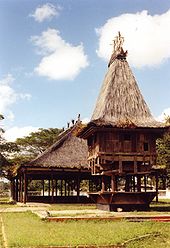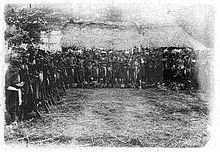Traditional Timor religion

The animist traditional religion of Timor was the dominant ethnic belief on the island well into the 20th century . When East Timor gained independence from Portugal in 1975, only about 30% of the population were Catholic . The Christianity was on the capital Dili limited and few larger cities. The rites and contents vary within the different ethnic groups of Timor, but common elements were present among all ethnic groups.
Main features
At the center of the religion is the Dato-lulik or ra ulik , the local priest who served as a mediator to the spiritual world. " Lulik " means something like "holy" or " taboo ".
The Dato-lulik is the main actor in animal sacrifices that take place during special events in the life of the Timorese. The animal sacrifices are offered to the spirits of the ancestors and the nature spirits who live in the woods, stones and waters. These materialize in rivers, mountains, forests and gardens. One of these holy places is Mount Matebian . The spirits of the ancestors are said to live here. There are different ceremonies for the different events in life, such as washing the eyes ( fasematam ) during a birth or the ceremony of cutting hair ( tesifuk ). Journeys are also not taken as long as the spirits do not give their consent. Some chicken is offered as an offering to ghosts living in the treetops before a tree is felled. Rice cultivation is also accompanied by ceremonies.
In earlier times a large part of the farm animals was sacrificed. In 1936, the Portuguese colonial rulers viewed this as a waste of thousands of animals annually. Therefore restrictions have been imposed. The sacrifice of female animals of childbearing age was completely prohibited. Animal sacrifices had to be approved for a fee. But even the registration of all farm animals and high penalties did not stop the sacrifices. They were mostly carried out in secret.
Other components of the religion are the ancestor cult and the veneration of relics . The relics and sacred objects ( Sasan Lulik ) are kept in the holy relic houses, the Uma Lulik . It has a door to the front and one side, is fenced in and decorated with buffalo skulls . One of the two doors is reserved for the Dato-lulik, the other is for those who want to ask him for advice. Every Timorese village used to have an Uma Lulik, and the largest of the empire stood next to the Liurai , the traditional petty king's house. Nowadays Uma Luliks are being rebuilt, even if the population mostly calls themselves Catholic. In addition to the sacred objects, the ceremonial jewelry of the Dato-Luliks is kept in the Uma Lulik. A round, metal breastplate ( belak ), bracelets and a crown with long buffalo-like horns, the Kaibauk . Each family has their own little reliquary. Small figures, which represent the ancestors, guard the entrance to the village and are also taken everywhere by the Timorese. The most sacred object is the Batu-lulik . This stone is said to have been given to the Timorese for making offerings when the world was created. Animals and plants can serve as totems that can apply to entire clans. There are special diet taboos for clan members. The crocodile living in Timor is greatly worshiped . According to the Timorese creation myth Lafaek Diak , the island emerged from the body of a giant crocodile. The Timorese therefore call the crocodile grandfather .
The Liurai drew their claim to power partly from the possession of the sacred objects. These could be buffalo skulls, spears, old uniforms, firearms or symbols of deceased Liurais. When the Portuguese occupied the country, the Timorese accepted the leaders of the Portuguese in their hierarchy as higher up with a larger army and holy men, the Catholic priests, with a larger luli. The Liurai confirmed as administrators of Portugal were legitimized again by handing over the flag. The flag of the Portuguese and even the flagpole were therefore seen as sacred objects. Flag worship is of central importance to the Mambai , who swore the Portuguese oath of loyalty when Dilis was founded.
The head-hunting was to the 20th century, a tradition that some militias experienced a renaissance during the turmoil of the Indonesian occupation of East Timor. Originally, it was often used to gain ritual and social prestige. The heads of the slain enemies were carried to the village of the ancestors, accompanied by dark chants (the lorsai ) and the Likurai dance of the women, where they served as lulik . But if a peace agreement was reached between the warring parties, the captured heads were returned to their home group. Cannibalism was unknown in Timor. Blood oaths to secure alliances and blood revenge were common. The constant turmoil in colonized Timor, both in the Portuguese and in the Dutch part, can be explained by the aspect of ritual warfare, which is called Funu in the Tetum .
Todays situation
During the freedom struggle against Indonesia (1975-1999), the Catholic Church became the unifying bracket between the twelve larger tribal associations of East Timor against the predominantly Muslim Indonesians. Today only about 0.3% (2010) of East Timorese are animists. In West Timor , the proportion of animists is similarly low. Christian missionaries had their first successes in this area as early as the beginning of the 20th century, and here too Christianity serves as a delimiting element against the Muslim majority of Indonesia. However, a survey in West Timor in 2001 showed that more than 70% of the population are still rooted in ancestral cult and belief in spirits. Christianity in Timor is heavily pervaded by traditional rites in both parts of the island.
There are also a number of Timorese youth movements with a few hundred to a few thousand members, such as Colimau 2000 or the Sagrada Família , whose ideologies have quasi-religious traits. These groups use Christian and also animistic elements, such as the belief that dead fighters of the independence struggle against Indonesia could rise again, to help the groups in the fight. There are also kakaloks (magical groups), such as 7-7 ( seven-seven ), to which magical powers are attributed. 7-7 has many young members with fresh, noticeable scars, which suggests that unlike other magical groups, she continues to actively recruit. 7-7 has recently appeared as a martial arts club.
Others incorporate biblical stories into their local legends. So the mythical first ancestors Adam and Eve are called or it is explained that the Virgin Mary was born in Laclubar . In this way the origin of mankind is to be moved to Timor and it is to be proven that the Catholic faith has always been part of the Timorese culture. The Roman Catholic Church in East Timor is seen as a supporter of rituals for the ancestors, no longer as an opponent. She integrated various beliefs, concepts and rites into her practices.
The Uma Lulik , the holy houses with their special shape are a national symbol in East Timor. Therefore, new houses are still being built today. The oldest Uma Lulik still in existence is in Tineru in the Bobonaro municipality .
Festivals
See also
literature
- Judith Bovensiepen: Lulik: Taboo, Animism, or Transgressive Sacred? An Exploration of Identity, Morality, and Power in Timor-Leste , Oceania, Volume 84, 2014, pp. 121-137, doi : 10.1002 / ocea.5049 .
Web links
- Northern Illinois University, Religion: Catholicism and ancestral cults
- Andrew McWilliam: Austronesians in linguistic disguise: Fataluku cultural fusion in East Timor (PDF; 171 kB)
- Uma Lulik, Future of Tradition , film documentary about holy houses in East Timor (Portuguese)
- Josh Trindade: Lulik: The Core of Timorese Values
supporting documents
- Geoffrey C. Gunn: History of Timor. Technical University of Lisbon (PDF file; 805 kB)
- Monika Schlicher: Portugal in East Timor. A critical examination of the Portuguese colonial history in East Timor from 1850 to 1912 . Abera, Hamburg 1996, ISBN 3-931567-08-7 , ( Abera Network Asia-Pacific 4), (also: Heidelberg, Univ., Diss., 1994).
Individual evidence
- ^ A. McWilliam, L. Palmer and C. Shepherd: Lulik encounters and cultural frictions in East Timor: Past and present , pp. 309 ff., 2014, Aust J Anthropol, 25: 304-320. doi: 10.1111 / taja.12101 , accessed December 12, 2017.
- ↑ Direcção Nacional de Estatística: Population and Housing Census 2010, Population Distribution by Administrative Areas, Volume 2 ( Memento of the original from January 5, 2017 in the Internet Archive ) Info: The archive link was inserted automatically and has not yet been checked. Please check the original and archive link according to the instructions and then remove this notice.
- ↑ Scamberi, James: A Survey of Gangs and Youth Groups in Dili, Timor-Leste (PDF; 3.1 MB), accessed on May 20, 2012.
- ↑ Scamberi, James: A Survey of Gangs and Youth Groups in Dili, Timor-Leste (PDF; 3.1 MB)
- ^ Judith Bovensiepen, Frederico Delgado Rosa: Transformations of the sacred in East Timor , pp. 35 ff., Accessed on December 27, 2017.





